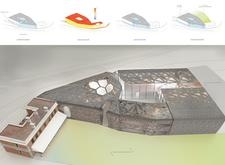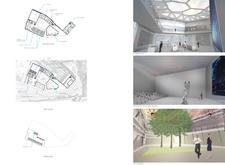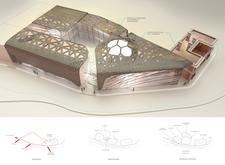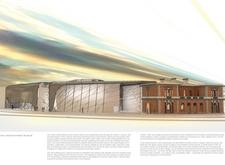5 key facts about this project
The project’s primary function is to provide an interactive environment where visitors can explore the complexities of internet technology and its societal implications. Designed as an educational resource, the museum features multiple exhibition areas, interactive displays, and workshops aimed at various demographics, from school children to technology enthusiasts. This focus on education is underscored by dedicated spaces for forums and discussions, allowing community members to engage deeply with the subject matter.
An essential aspect of the design is the blending of the old and the new. The building's exterior reflects a modern architectural language, predominantly featuring a sleek façade of aluminum and glass. This contemporary skin is complemented by the preservation of the existing red brick structure, which serves to honor the architectural heritage of London. The juxtaposition of traditional materials with forward-thinking design highlights the museum’s role as a bridge between past technological achievements and future developments.
The spatial organization of the museum is well-considered, designed to create a seamless flow between different areas. The ground floor includes a Tech Garden, where outdoor exhibits can thrive in a natural landscape, providing an inviting entrance for visitors. This innovative approach encourages interaction with both the exhibits and the surrounding environment. The second floor caters to more advanced engagement, featuring classrooms and a restaurant, further emphasizing the museum’s role as a communal space. Each area is adaptable, designed to accommodate a variety of events and activities.
Materiality plays a crucial role in the project. The choice of aluminum and glass not only supports sustainable practices—due to their energy-efficient properties—but also provides an aesthetic that beautifully contrasts with the textured warmth of the brick. The incorporation of a solar cell underskin within the façade reflects a forward-looking approach to energy consumption. This design consideration demonstrates a commitment to reducing the museum's carbon footprint, while enhancing its operational efficiency.
The museum's architecture incorporates advanced climate-responsive features, including a comprehensive solar analysis that optimizes natural light and ventilation. These elements are essential in creating an environment that is both comfortable for visitors and minimally impacting on energy resources. This attention to climatic context and energy use is a hallmark of modern architectural philosophies that value sustainability.
Moreover, one of the unique approaches taken in this project is its emphasis on future adaptability. The design not only responds to current technological trends but also anticipates future innovations in digital culture. By allowing for flexible spatial configurations, the museum can evolve alongside the rapidly changing landscape of technology. This adaptability positions the museum as not only a reflection of contemporary internet culture but also as a platform for future developments.
In summary, the London Internet Museum serves as a vital nexus for learning and community engagement regarding internet technology, interweaving historical reverence and contemporary architectural practices. Its carefully designed spaces promote interaction and education, making it a significant addition to London’s cultural landscape. Those interested in a deeper exploration of the project are encouraged to review the architectural plans, sections, and designs to gain further insights into the innovative approaches embodied in this exceptional architectural endeavor.


























